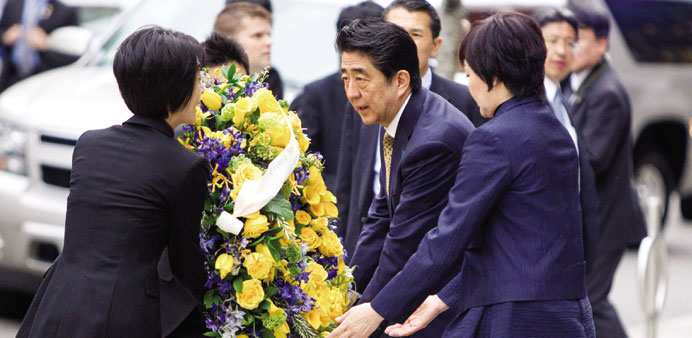Prime minister Shinzo Abe and his wife Akie Matsuzaki place a wreath at the site of the Boston Marathon Bombings yesterday.
AFP/Tokyo
The United States and Japan unveiled new rules for defence cooperation yesterday in a historic move that will give Japanese armed forces a more ambitious global role amid concerns over China’s rising sway.
Under the revised guidelines, Japan could come to the aid of US forces threatened by a third country or, for example, deploy minesweeper ships to a mission in the Middle East.
US secretary of state John Kerry and defence secretary Ashton Carter and Japanese foreign minister Fumio Kishida and defense minister General Nakatani revealed the new rules after talks in a New York hotel.
Although officials said the new doctrine is not aimed at China, there has been increasing concern over moves by Beijing to try to scoop up disputed areas of the South China and East China Seas.
But they pointedly made mention of North Korea as another source of tension in the region.
Kerry stressed that the United States saw the disputed Senkaku islands, known in Chinese as the Diaoyus, as firmly under Japan’s control.
Washington “commitment to Japan’s security remains ironclad and covers all territories under Japan’s administration, including the Senkaku islands,” Kerry said. The sovereignty of the isles have been the source of friction between Tokyo and Beijing for decades.
“Today we mark the establishment of Japan’s capacity to defend not just its own territory, but also the United States and other partners as needed,” Kerry told a joint press conference in a New York hotel.
“This is an historic meeting. It’s a historic transition in the defence relationship between our two countries.”
The guidelines came a day before US President Barack Obama rolls out the red carpet at the White House for Japanese Prime Minister Shinzo Abe for a high-profile visit.
Kerry paid tribute to Japan’s expanded role in international peace-keeping in far flung places such as South Sudan, adding that Tokyo’s defence capabilities had been transformed “during a period of evolving risks and dangers both in the Asia-Pacific and across the globe”.
Japan’s Nakatani said that since 1997, when the defence ties were last revised, “the security environment in the United States and Japan has changed dramatically.”
The new guidelines would “draw a picture of the Japan-US alliance for the next decade and beyond”, Nakatani said.
In an implicit reference to China, Kerry said: “We reject any suggestion that freedom of navigation, overflight and other unlawful uses of the sea and airspace are privileges granted by big states to small ones, subject to the whim and fancy of the big state.”
Under the previous rules, Japanese forces could assist American troops only if they were operating in the direct defence of Japan.
The amended guidelines were drawn up to reflect a reinterpretation of Japan’s constitution by Abe’s government last year, which allows for “collective defence”.
Carter said the new rules removed the constraints of geography, adding that now the US-Japan cooperation had moved “from being locally focused to globally focused, and of course that’s completely appropriate given the way the world has changed since 1997”.
“It means that Japan can defend US ships engaged in missile defense activities in the vicinity of Japan,” a US official said earlier.
“It means that Japan can respond to attacks on third countries if they are in close association with Japan and if those attacks directly affect Japanese security,” he said.
One possible scenario could have Japan shooting down a missile headed towards the United States, even if Japan itself was not under attack, officials said.
The reinterpretation of the constitution and the new defence guidelines are part of Abe’s bid to soften Japan’s constitutional commitment to pacifism. The United States imposed the principle after World War II, but now strongly supports Japan’s new approach.
Tokyo’s readiness to embrace what Abe calls “proactive pacifism” comes amid growing anxiety in Japan and across Asia over China’s rising military and economic might.
For Washington, the new guidelines could make Japan a more active and equal military partner, able to support US-led operations elsewhere and cooperate more closely on missile defence, cyber security and surveillance satellites.
High politics will dominate Japanese Prime Minister Shinzo Abe’s visit to the White House today, but there will still be time for some haute cuisine.
At a state dinner Abe, US President Barack Obama and hundreds of other guests will tuck into an array of food that links Japan and the United States, with a touch of influence from president Obama’s home state of Hawaii.
For starters guest chef Masaharu Morimoto, star of Iron Chef, will rustle up his fusion take on a salad classic -- the Toro Tartare and Caesar Sashimi Salad.
“The salad is wrapped in a clear acetate and tied with Mizuhiki cord emulating a gift to be opened,” according to the programme.Then a consomme will be given a twist with bok choy and Wailea hearts of palm and bamboo shoots from Hawaii.
“This is served with a crisp Hawaiian pineapple tempura topped with a sliver of cured ham from Virginia.”
The main course will be roasted American wagyu beef with spring vegetables.
For dessert the American-style cheesecake will get a spin with the addition of silken tofu and soymilk and a selection of seasonal berries from Florida.
All the dishes will be served on a new 11-piece State China Service, which was designed by Michael Smith in consultation with first lady Michelle Obama.
Instead of opting for the traditional primary red or blue normally seen, the first lady opted for a blue “inspired by the waters” off the coast of Hawaii -- a “Kailua blue”.
The food will be washed down with sake -- Dassai’s 23 for a toast -- a Freeman 2013 “Ryo-fu” Chardonnay and a 2010 Morlet Pinot Noir.



